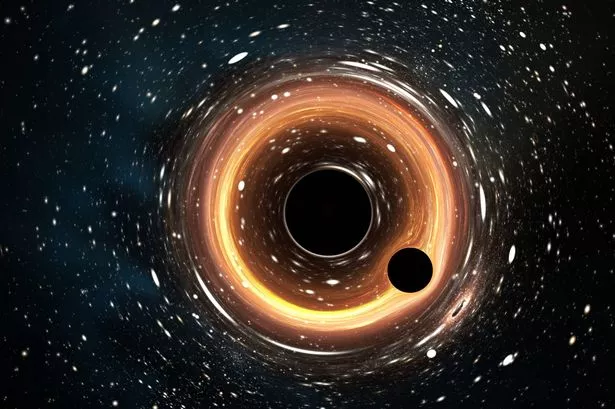Science
Researchers Reveal Supermassive Black Holes Smaller Than Expected

A groundbreaking study has revealed that supermassive black holes may not be as massive as previously believed. Researchers from the University of Southampton, in collaboration with European partners, have utilized advanced telescope technology to examine a young galaxy located 12 billion light years away. Their findings indicate that the supermassive black hole at the center of this distant galaxy is approximately ten times smaller than prior estimates suggested.
This research addresses a long-standing scientific conundrum regarding the growth of supermassive black holes in the early universe. Professor Seb Hoenig explained that for years, scientists have grappled with the existence of fully formed supermassive black holes in young galaxies shortly after the Big Bang. He stated, “We have been wondering for years how it’s possible we discovered all these fully grown supermassive black holes in very young galaxies shortly after the Big Bang. They shouldn’t have had the time to grow that massive.”
The research, published in the journal Astronomy and Astrophysics, employed the cutting-edge Gravity+ instrument. This technology integrates light from four of the world’s most powerful optical telescopes located at the European Southern Observatory’s Very Large Telescope in Chile. The team, comprised of researchers from France, Germany, Portugal, and Belgium, focused on an ancient quasar, a galaxy with a remarkably bright black hole that serves as a “cosmic beacon” from the universe’s early moments.
Their observations revealed a swirling mass of super-hot gas surrounding the black hole, weighing in at 800 million times the mass of our Sun. Interestingly, much of the gas approaching the supermassive black hole is not being consumed. Instead, it is expelled at high velocity. Professor Hoenig likened this phenomenon to a “cosmic hairdryer set to maximum power,” explaining, “The intense radiation around it is blowing everything away that approaches it.”
This unique gas movement is crucial for accurately measuring the black hole’s mass. The researchers suggest that the energetic outflow during this “feeding frenzy” may have led previous studies to significantly overestimate the sizes of black holes.
The implications of these findings are profound, as they could necessitate a reevaluation of current models regarding cosmic evolution. As scientists refine their understanding of the universe’s earliest black holes, the research promises to reshape fundamental concepts in astrophysics.
-

 Technology5 months ago
Technology5 months agoDiscover the Top 10 Calorie Counting Apps of 2025
-

 Technology3 weeks ago
Technology3 weeks agoOpenAI to Implement Age Verification for ChatGPT by December 2025
-

 Health3 months ago
Health3 months agoBella Hadid Shares Health Update After Treatment for Lyme Disease
-

 Health4 months ago
Health4 months agoAnalysts Project Stronger Growth for Apple’s iPhone 17 Lineup
-

 Health4 months ago
Health4 months agoErin Bates Shares Recovery Update Following Sepsis Complications
-

 Technology5 months ago
Technology5 months agoDiscover How to Reverse Image Search Using ChatGPT Effortlessly
-

 Technology3 months ago
Technology3 months agoElectric Moto Influencer Surronster Arrested in Tijuana
-

 Technology5 months ago
Technology5 months agoMeta Initiates $60B AI Data Center Expansion, Starting in Ohio
-

 Technology2 months ago
Technology2 months agoDiscover 2025’s Top GPUs for Exceptional 4K Gaming Performance
-

 Technology5 months ago
Technology5 months agoRecovering a Suspended TikTok Account: A Step-by-Step Guide
-

 Health5 months ago
Health5 months agoTested: Rab Firewall Mountain Jacket Survives Harsh Conditions
-

 Lifestyle5 months ago
Lifestyle5 months agoBelton Family Reunites After Daughter Survives Hill Country Floods




















